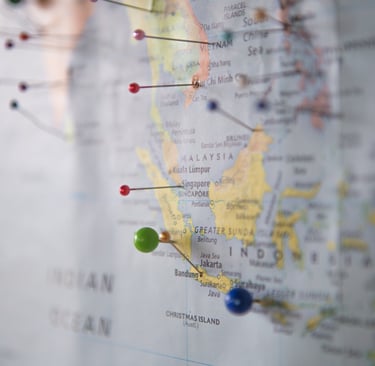A Concise Guide to Expanding Your Business to Asia
ASIA BUSINESS FACTS
Alan Wong
5/16/20237 min read


Why is expanding a business to Asia important?
As the world becomes increasingly digitized, every startup should take a global view to expand business to all parts of the world.
Asia region is home to more than half of the world's population and some of the fastest-growing emerging economies.
To truly succeed in the East, companies must go deep into their target countries to localize and expand business to the local businesses and population.
In this guide, we have identified some of the most important topics for expanding your business in the Asia region.
What to consider when expanding a business? Research the Market
Conduct thorough research on the target countries to understand their market size and growth potential.
For example, when expanding a business to India because it has a huge population but you should understand the customer needs, local competition, and regulatory environment before.
Many agencies and consulting companies can help you do this, but sometimes the best way to go about is to search for a company that has done this before themselves; that is taking a similar company to market in your target country.
In addition, you need to keep an open mind about different markets and their possibilities, sometimes just because a consultant comes back to tell you that "it cannot be done", it may just mean it has not been done before but it is not necessarily "cannot be done".
Agencies and consultants usually take a more conservative path which sometimes may be different from an entrepreneurial mindset.
So keep an open mind on the outcome of any market research done.


The Key Step for Asia Business Expansion: Content Localisation
Adapting your product and marketing content to cater to the local language in certain markets in Asia like Japan and South Korea is almost mandatory.
This may involve translating your platform, offering customer support in local languages, and creating culturally relevant marketing materials to tap into the market.
Often companies take a very simplistic view of this by hiring a freelance translator to do the work.
This may sound logical, however, it is essential to go deep into the localization process to get the desired result, and not every agency has the expertise on how to do this.
The Key Step for Asia Business Expansion: Partnerships and Collaborations
Establishing partnerships with local Asia companies or distributors to leverage their existing networks, customer base, and market expertise is a great strategy.
This may include resellers, system integrators, or other relevant service providers.
Besides, they help you navigate cultural differences, legal regulations, and other challenges that may arise when entering a new market like India.
But unless you already have a very well-known or popular product in Asia, it will be hard to have a partner who will give you the attention and resources that are required to be successful.
The Key Step for Asia Business Expansion: Check Regulatory Compliance
Ensure that your offering complies with local laws and regulations,
including business licensing, data privacy, taxation, and cybersecurity.
This may involve setting up local data centers or
partnering with local providers for data storage and processing.
Depending on the country you will set foot in, there are different requirements.
In certain places, it is easier to start a Joint Venture or
partner with an experienced operator to get around these compliance issues.
At ToAsia.biz, we have years of working relationships with many independent law firms and
accounting firms in various countries where they can help with your needs in this area.
This ensures we provide you with a one-stop-shop solution for your expansion needs.
Your Asia Business Expansion Plan should include a Tailoring price
Did you know that the price of a Netflix subscription is different in different parts of the world?
Tailoring your pricing strategy to match local affordability and demand,
considering factors like currency exchange rates and purchasing power.
For example, the purchasing power of Hong Kong, South Korea, Malaysia, and even India are different.
The key is to find a sweet spot where your product sells well yet
you are profitable in a target market where you are still competitive.
Packaging other add-ons and value-added products is also a very common way
to promote your product and pricing in Asia Pacific.
Remember to do your research to see
how you can package things together to appeal to your target customers.
Your Asia Business Expansion Plan should have different Payment Methods
Offer a variety of payment methods popular in Asian countries can be like a maze,
there are many more payment methods and merchants than Visa or Mastercard, and American Express,
not to mention the modern forms of payment methods
such as mobile payments (WeChat Pay, Alipay Line Pay), local e-wallets,
QR code payments, or bank transfers. Each has its associated costs, pros, and cons to consider.
Business Expansion Plan to Asia includes Marketing and Sales strategies
Adapting marketing and sales strategies to fit the local market is crucial for success in the Asian Market.
Different countries may have different preferences for marketing channels, messaging, and pricing.
For example, in China, WeChat 微信 and Red 小紅書 are popular social media other than Facebook and Instagram.
In Japan, LINE is the most popular which is similar to Taiwan but traditional media in Japan like television and print are still widely used.
In South Korea, KakaoTalk is the equivalent social media platform.
Leveraging search engine optimization (SEO) like Naver in South Korea which is the Google equivalent and suitable digital marketing tactics to build local brand awareness and reach potential customers in each target country is the key.
Therefore, it is important to understand the local market and cultural differences by conducting market research, gathering feedback from local partners and customers, and adapting your messaging and pricing to fit the local market in the very first step.
Establish a local presence before expanding the business into Asia
Local presence is the need to have a local team to face your customers and prospects.
Whether it is over the phone to speak the right local language or offer local support talents to those who understand the local needs and help make your customer feel they can "find you" during their business hours.
Localizing your product is also essential for success in the Asian Market, this includes language, user interface, and support where language and cultural differences can greatly impact business performance.
To localize your product, start by translating your website, user interface, and support materials into the local language.
Consider localizing your pricing and payment methods to fit local preferences.
Additionally, it may be helpful to hire local representatives or local experts to build trust with local businesses.
Our typical suggestion is to start by opening a local entity in Singapore, Hong Kong, or Australia.
It is much easier to hire good and honest people in these places.
Also, they are typically protected by a more familiar legal system in your local country.
There are many tips and tricks on this topic, if you looking for some practical advice, contact us for a free consultation about how to localize your presence.


Get ready for customer support before expanding the business into Asia
Imagine I try to sell you a product or service, but tell you that we do not have support in your timezone yet but it will come in 6-12 months.
"Despite this, we have a very good team that can support you during your night and
you will get a response first thing in the morning".
Would you be interested in engaging this company where every time you have an issue, the response will be T+1, not to mention the difficulty of escalating by talking live to a manager or someone if things do go wrong?
Asia Pacific is a service-oriented market.
Providing responsive and efficient customer support is a prerequisite.
This may involve setting up a local call center and engaging a partner to set up a service hotdesk in addition to other technologies-enabled customer service tools such as chatbots.
Most importantly, offering support in the local language and time zone is a must.
Monitoring and being agile are critical when expanding the business into Asia
Continuously monitor your performance in each market, and be prepared to adapt your strategies based on feedback and changing market conditions.
Then put more investment and resources in the richer markets where you are getting more of your return on Investment.
No matter how passionate you are about your product don't indulge in how much your customers love your product.
If you are not getting paid on time, you will not make it.
Therefore it is imperative that you actively monitor your cash business model and have an Agile mindset to adapt to changes.
For example, every one of your vendors wants you to pay them early but all your customers want to pay you only when they have to.
So finding an operation model to fit this in a different country and culture may be challenging for you.
In these situations, recruiting a local team in your company will help you go a long way with this.
Each country in the Asia Pacific region has its unique challenges, business cultures, and opportunities like the language barriers in Japan, the business environment in China, the working style in Southeast Asian countries, etc.
Tailoring your expansion strategy to the specific needs and characteristics of each market will be critical to your success.
With over 50 years of experience in Asia Pacific combined at ToAsia.biz, our business growth experts understand the needs of Western startups.
Talk to us early to get your business ready to expand your business to the Asia Pacific region - Profitably.


Alan Wong is founder of ToAsia.biz and a startup mentor with over 20 years of professional experience managing software, Saas and consulting services MNCs.
About Author
Copyright © 2025 ToAsia.biz


We lead your business to Asia
Our Business Growth Experts help SaaS businesses achieve growth in Asia and become profitable FAST.
Send us a message via WhatsApp
